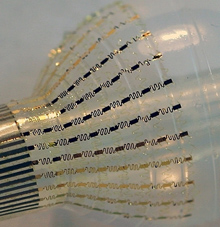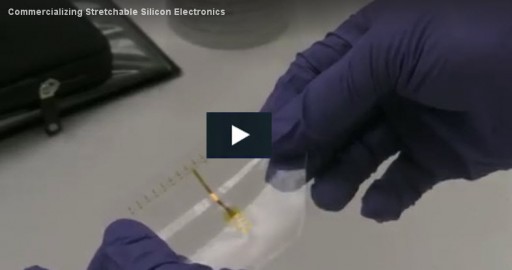Stretchable Silicon Sensors Could Speed Up Heart Surgery
May 5, 2011 | Source: Technology Review

Balloon catheter covered with a mesh of electrical and temperature sensors and wires (credit: UIUC & MC10)
Stretchable silicon, a new surgical technology, uses hundreds of thousands of stretchable sensors embedded on the surface of a balloon catheter to map electrical problems in the heart, such as atrial fibrillation.
The technology was recently developed at MC10 Inc. and successfully tested on animals by John Rogers at the University of Illinois at Urbana-Champagne and colleagues.
Conventional balloon catheters can be outfitted with one or two electrical sensors and inserted in the heart to examine the electrical properties of normal and damaged tissue. With only a couple of sensors however, the process can be time-consuming.
This new device could speed up the process by bringing hundreds of thousands of sensors to bear, where 1 or 2 would have previously had to suffice. It can also be outfitted with a combination of sensors and heating elements so that once in place it can ablate damaged tissue, eliminating the need for a second catheter, as is standard practice.
The device has yet to be approved for use in humans.
CORRECTION: The device was developed at MC10 Inc., not UIUC.
Ref.: Materials for Multifunctional Balloon Catheters with Capabilities in Cardiac Electrophysiological Mapping and Ablation Therapy, Dae-Hyeong Kim, Nanshu Lu, Roozbeh Ghaffari, Yun-Soung Kim, Stephen P. Lee, Lizhi Xu, Jian Wu, Rak-Hwan Kim, Jizhou Song, Zhuangjian Liu, Jonathan Viventi, Bassel de Graff, Brian Elolampi, Moussa Mansour, Marvin J. Slepian, Sukwon Hwang, Joshua D. Moss, Sang-Min Won, Younggang Huang, Brian Litt & John A. Rogers. Nature Materials 10, 316–323 (2011) doi:10.1038/nmat2971
